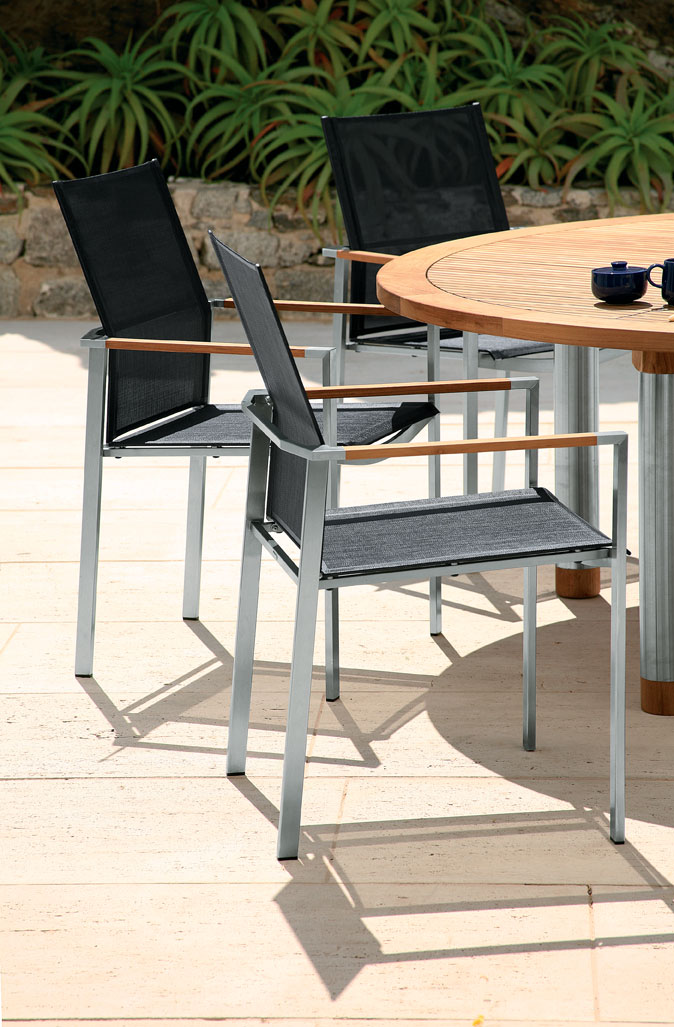Colors and Hues for Your Patio and Outdoor Furniture

Today we are pleased to feature a guest post by Pierre Angela on how to maximize your outdoor space for usability and style. Patios and other outdoor areas are the perfect places to relax and take in the beauty of nature in your own backyard. However, the furniture used for these spaces is subjected to the forces of nature, making its lifespan shorter than indoor furniture. Having the same old fixtures can also make your patio boring over time.
Instead of buying a whole new set of furniture, you can use existing pieces from around your home to spruce up your outdoor space.
Mix and Match through Color
When using pieces of furniture from different sets for one area, the most important factor is the color. Color is what brings contrasting styles together, and it is what makes an already good combination even better.
Repeat.
A color and its varying shades can be used as a motif for stylistically different furniture pieces. If you choose green, you should keep to its varying shades, such as lime or chartreuse. Whatever your choice, there should only be one major color if this method is to be utilized to keep a unifying theme. Color palate consistency is very pleasing to the eye.
Complement.
Primary and secondary colors that are opposite each other on the color wheel can offer a certain level of evenness and contrast. Blue and orange, yellow and violet, and red and green are such examples of complementary colors.
Contrast.
Although this can be tougher to pull off than the previous two methods, having two colors from completely opposite sides of the spectrum can really make a room pop. Traditional looking outdoor furniture pieces are usually made of wood, and contrasting them with fairly muted green or blue can add a modern feel.
Use Blacks and Whites.
These two are technically not colors, but they have even more uses when designing a room than most true colors. White furniture pieces light up an area, leave a feeling of cleanliness, control bright colors, and set boundaries. Black pieces of furniture allow other colors to stand out, give weight to a room, and focus the eyes.
Enhancing Outdoor Furniture
With an understanding of how colors work in furniture, it can be used with other factors to enhance even the oldest and dullest outdoor furniture.
Keep assorted furniture looking organized through repetition. The same kinds of furniture with different designs such as chairs of varying heights on a patio can be off-putting unless they share something in particular – color.
Match furniture with decorative items. The dominant hues of objects like paintings, lamps, vases and other baubles should match with the big pieces of furniture.
Accentuate through blacks. As mentioned earlier, black objects can work as highlights. Placing light colored throw pillows on black sofas, or a black table in the center of white patio furniture will catch attention.
Use two complementary colors for two different furniture pieces. Soft orange chairs can moderate the vibrancy of a bright red table. These kinds of color combinations can bring a modern sensibility to the outdoor area, while keeping the warmth inherent in the surrounding environment.
Space out furniture equally. Applying symmetry to furniture is a reliable method of attaining order, even with diverse pieces. A long glass table with two big iron-wrought chairs on each end and a set of smaller wicker chairs on each side will look neat but striking.
Frame separate areas. A patio can also be made visually attractive through giving areas boundaries. You can use rugs for table and chair arrangements, and potted plants as dividers or as a surrounding border.
Placement of Outdoor Furniture
The above tips can be used to maximum effect through proper arrangement of furniture. To achieve this, one should follow these general directions:
Keep doorways free of obstruction. People should be able to get to the outdoor area without having to weave through furniture.
Consider the shape and size of the furniture. Pieces of furniture from different sets will no doubt take on various shapes and sizes. Whatever you use, furniture should allow people to walk through an area comfortably without looking so small that it makes the patio look barren.
Place the biggest pieces of furniture near the edges. Long benches should be almost flush against walls or railings. This allows room for smaller furniture throughout the area, while also keeping the space from looking crowded.
Keep people together. Chairs should not be spaced far apart. People visit patios for relaxing conversations while dining or taking in the views. Having chairs close to tables will make the space more livable.
Patios and other such outdoor areas are great places for leisure and social gatherings. By switching up furniture styles and achieving the right balance, they can liven up the mood for even greater experiences.
Pierre Angela Cruz is a Marketing Consultant for Open Brook, an excellent source of information and reviews about patio and outdoor furniture .




